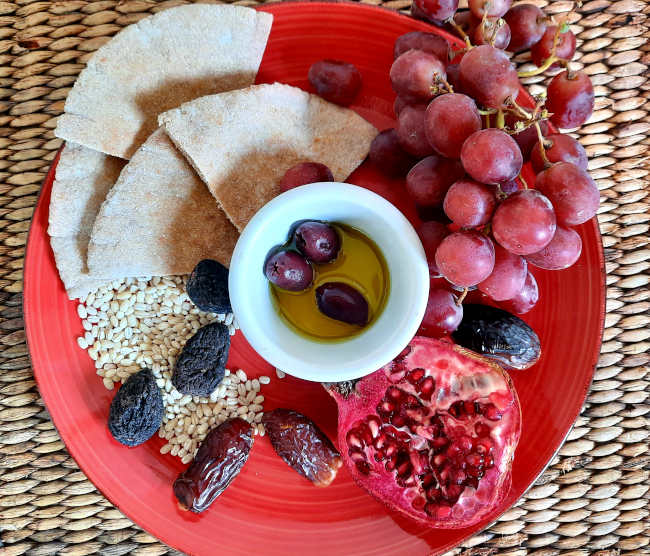- ESTHER OERTEL
- Posted On
Mensam Mundum — World Table: Israel’s complex cuisine

Today marks the first day of Hanukkah, and in its honor, we’re going to explore the complex food culture of Israel.
We’ll also hear from a few folks who’ve got local as well as Israeli connections to get their take on the food there.
Israeli cuisine is influenced by a plethora of factors — immigration from other countries, other Mediterranean and Middle Eastern cuisines, various styles of Jewish cooking, the tradition of keeping kosher, food customs associated with Shabbat (the weekly seventh day of rest), year-round Jewish holidays, regionally available foods and world trends from chefs trained abroad.
Because of the great diversity present in Israeli food culture, it might be helpful to think of it as a patchwork of different cuisines, rather than a cohesive whole.
As Jews returned to Israel from the Diaspora, their scattering throughout the world, they brought with them foods and recipes from an astounding number of countries. In particular, the Mizrahi, Sephardic and Ashkenazi styles of cooking are prevalent throughout Israel.
Mizrahi Jewish cuisine has roots in the Middle East, North Africa, Asia and Arab countries. Flatbreads, lentils, chickpeas and rice are staples of this cuisine, and spices popular in the Middle East are favored, among them cumin, coriander, cinnamon, black pepper, sesame seeds and spice blends such as za’atar.
Sephardi Jews are the Jews of Spain and Portugal. When they were expelled from those countries in the 15th century, many settled in North Africa — Tunisia, Libya, Morocco and Egypt — as well as in Greece, Turkey, the Balkans, Lebanon, Syria and the Holy Land. Their cuisine has been influenced by these many countries.
It emphasizes salads, stuffed vegetables and vine leaves, olive oil, lemon, lentils, dried fruits, herbs such as cilantro and parsley, saffron, nuts, chickpeas, and a variety of spices, including cumin, turmeric, cardamom and cinnamon.
Because of similar influences, Mizrahi and Sephardim cuisine overlap and share many dishes in common.
Ashkenazi Jewish cuisine developed among Jews throughout Europe, particularly Eastern and Central Europe. The Jewish dishes that we’re familiar with in this country — things like latkes (the potato pancakes made during Hanukkah), challah (braided bread), matzo ball soup, strudel, and Jewish deli staples — are of Ashkenazi origin.
The cuisine is based on ingredients available to the historically poor Ashkenazi community of Europe. At one time they were forbidden to grow crops, so the food is less vegetable focused than Mizrahi or Sephardic cuisine.
Baked goods, potatoes, cabbage, beets, chicken, fish and less expensive cuts of beef such as brisket are featured. Due to the lack of availability of the olive oil used in traditional Jewish cooking, fat rendered from chicken skin, known as schmaltz, was used in many dishes.
Another factor adding to the diversity of Israel’s food is that the area that is modern-day Israel has been inhabited, conquered and fought over by countless peoples in its long history. It’s been a melting pot of world influence in times both ancient and modern.
Thanks to the Biblical and archaeological records that provide insight, many of Israel’s culinary traditions can be traced back to the time of the kings of ancient Israel, more than 3,000 years ago.
The ancient Israelites ate foods based on what’s known as the “seven species,” two grains and five fruits. These are mentioned in the Hebrew Bible (Deuteronomy 8:8) as being special products of the Land of Israel. They are wheat, barley, grapes, olives, pomegranates, dates, and figs. All retain an important place in Israeli cuisine today.
Arab foods, as well as foods from other Middle Eastern and Mediterranean countries, have been adopted and adapted by Israel. While the nation doesn’t have a food that can be considered a national dish (or even a distinct national cuisine), there are some foods that can be considered Israeli staples, and such regional influence can be seen in them. Below are a favored few.
Hummus, a dish that likely originated in ancient Egypt, is a smooth, silky paste made from chickpeas, tahini, lemon juice, cumin and salt. Sometimes olive oil is added. Hummus recipes vary from region to region. Jerusalem hummus, for example, is served with spicy ground beef and pine nuts.

Falafel is a popular street food and considered by some to be Israel’s unofficial national dish. Made from ground chickpeas rolled into balls and deep fried, falafel is often served in pita bread, or along with hummus or an Israeli salad.
Also a popular street food, shawarma is meat cooked on a spit and served with toppings in a pita. Toppings can include hummus, pickles, grilled hot peppers, pickled mangoes, olives, fried eggplant and even French fries.
Shakshuka is a bright and bold North African dish that’s become a quintessential part of breakfast or lunch in Israel. Eggs are cooked on a bed of tomato sauce spiced with paprika, cumin, and cayenne pepper and topped with fresh herbs when it comes out of the oven. It’s served in the pan it’s baked in.
An Israeli salad is made with finely chopped tomatoes and cucumbers and dressed in olive oil, lemon juice, salt, and pepper. Diced bell peppers, grated carrots, finely shredded cabbage or lettuce, sliced radish or fennel, chives, chopped parsley, and spices like mint, za’atar or sumac can be added for variety.
And finally, an “Israeli breakfast” is a common offering in hostels and hotels, however humble, and consists of a panoply of foods eaten there at breakfast, often including omelets, an Israeli salad, cheeses, olives, breads and pastries, labneh (thick yogurt), fruit and shakshuka.
I had the privilege of speaking with several former residents of Israel to learn about the food memories they hold and their personal Israeli food favorites.
Lisa Kaplan, executive director of the Middletown Art Center, moved to Israel with her family when she was 11 and lived there for 23 years. Her mother, a Palestinian Jew from Jerusalem, is from a family which has been rooted in the region since the 1700s.
Though it was mostly American or Ashkenazi food eaten in her family, her heart beats for the traditional Middle Eastern foods in Israel. It’s the hummus, lentils, rice, fresh salads and street food from the open-air markets that she craves.
A favorite of hers is kibbeh, ground lamb inside a bulgur coating (in form a bit like a corn dog, Kaplan said), which she got from the open-air market three blocks from her home. She visited there every Friday to buy vegetables.
A Moroccan friend in Israel taught her to make mejadra, a lentil and rice dish with onions and spiced with coriander and cumin. It’s still a favorite of hers and she makes it at home.
The foods and smells of the open-air markets in Israel influence the way she cooks here. She loves the way Middle Eastern flavors like lemon, garlic, olive oil, cumin and Baharat, a spice blend, tingle the palate and energize her.
If you ever get the chance to taste the hummus that Kaplan makes, do. It’s a labor of love and, from what I hear, tastes pretty darn good!
If you’ve been to a recent farm-to-table dinner at the Peace and Plenty saffron farm in Kelseyville, you’ve tasted Chef Arnon Oren’s food.
Melinda Price of Peace and Plenty Farm tells me that it’s been fun working with Chef Oren to create menus using their saffron and seasonal produce. Saffron was used in nearly every course of their last dinner (even in the ice cream, which is hugely popular). There’ll be further collaborations for dinners next year.
Oren was born in Israel and raised in a small town near the Sea of Galilee. His mother was an agricultural instructor, so, not surprisingly, their property included an abundant garden and was full of fruit trees.
This bounty — as Oren says, the original flavors of Israel — has influenced the flavor profile of his cooking. He believes in using the best ingredients possible and letting them shine.
Scents often evoke memories, and for Chef Oren, it’s the smell of fig leaves that takes him back to Israel, where he remembers plucking fresh figs from the trees of his childhood home.
He especially enjoyed Israel during Jewish holidays, which take place throughout the year, every couple of months or so, when everything seemed more pronounced. As is customary, his mother made jelly doughnuts during Hanukkah, and Oren laughed as he recalled their irregular shapes, unlike the perfect bakery versions.
Bourekas, fried pastries filled with cheese, are his go-to street food in Israel, and cardamom is a fondly remembered spice. His culinary creations often include cardamom — he uses it in sweet and savory applications, from chocolate cake to chicken.
His recipe for sweetened labneh with cardamom is offered for us today. Labneh is a Lebanese cream cheese that can be used as an accompaniment to sweet or savory foods.
Jivan Dicovsky, a Lake County life coach, was born in Israel and raised in Tel Aviv, one of its most populous cities. His family’s roots are in Western Europe and their style of eating reflected that; however, he grew to love Israeli food with Middle Eastern roots.
He began cooking after his divorce, including Israeli foods like hummus, falafel, and various soups and stews. He cooks almost exclusively Middle Eastern foods, though his favorite cold weather food to make is traditional Jewish chicken soup.
I also had the chance to chat with my youngest son, Billy Oertel, who visited Israel while he was in college. He found the mix of foods interesting, from Middle Eastern fare to Eastern European blintzes or pierogies.
He found it surprisingly easy to eat as a vegetarian there; there was always something meat-free on offer. The falafel was his favorite dish. He said it was the best he’s eaten, and though he’s been trying, he hasn’t found anything to match it here.
I especially wish to thank these folks for sharing their memories and thoughts with me.
To find out more about the Middletown Art Center, visit their website at www.middletownartcenter.org. For Chef Arnon Oren, who’s available to cater events in Lake County, visit www.anaviv.com, and for coaching by Jivan Dicovsky, see www.theartoffallingapart.life.
Chef Arnon’s Sweetened Cardamom Labneh with Fresh Fruit
1 quart whole milk yogurt
10 pods of green cardamom or 1 teaspoon cardamom powder
Zest from 1 lemon
2-4 tablespoons sugar
Fruit of your choice
Over a strainer that is over a bowl, pour the yogurt into a clean cloth towel.
Tie the cloth and hang it over a bowl in a sink at room temperature overnight. (Do not refrigerate.) You can also leave it in the strainer, although it is best to hang.
The next day, place the strained yogurt into a clean bowl. This is your Labneh. Save the liquid from the yogurt.
Grind the cardamom if you are using pods and sift it into the labneh. Otherwise, add the cardamom powder.
Add the sugar, lemon zest and mix well. You can add back some of the liquid if the labneh is too thick.
Serve with fruit of your choice and enjoy!
Recipe by Arnon Oren.
Esther Oertel is a writer and passionate home cook from a family of chefs. She grew up in a restaurant, where she began creating recipes from a young age. She’s taught culinary classes in a variety of venues in Lake County and previously wrote “The Veggie Girl” column for Lake County News. Most recently she’s taught culinary classes at Sur La Table in Santa Rosa. She lives in Middletown, California.












































